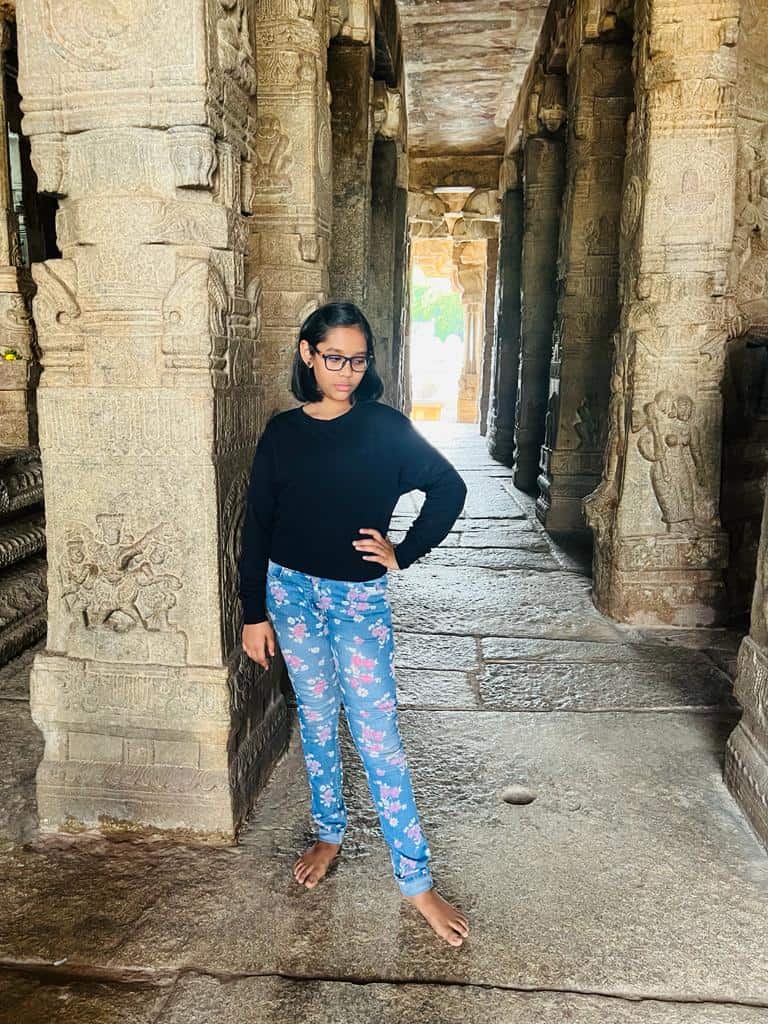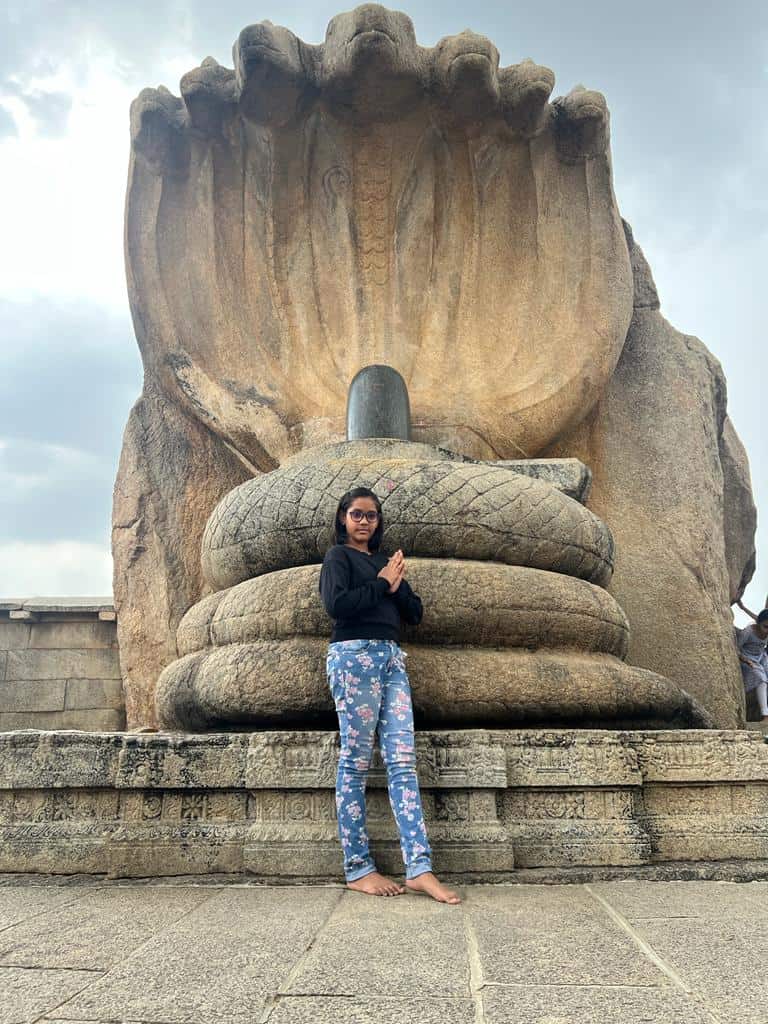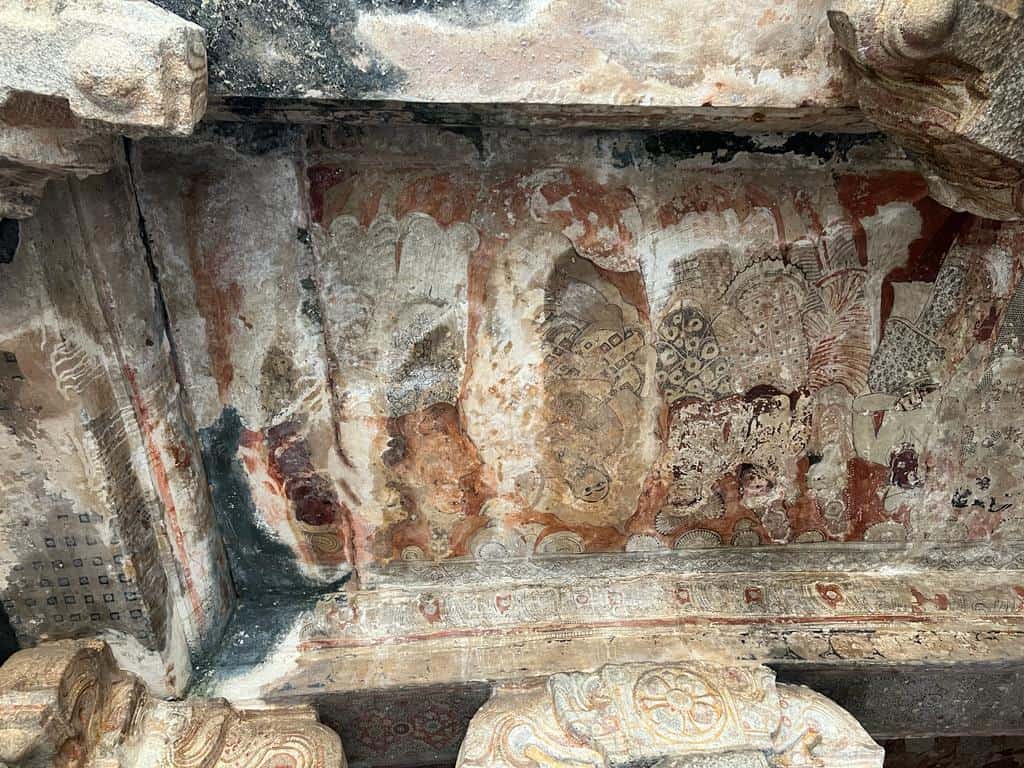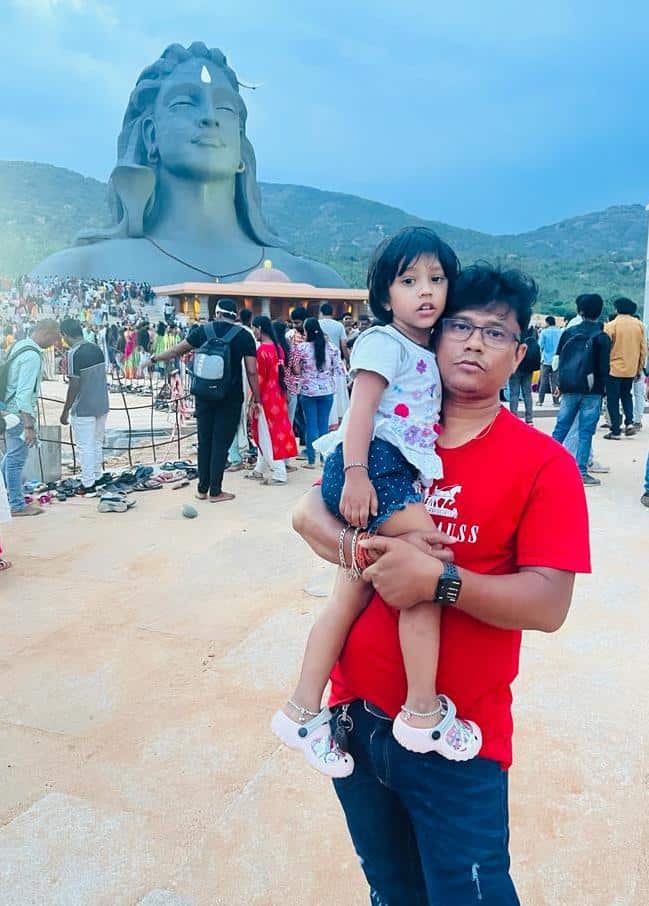Lepakshi is a small village situated in the Anantapur district of Karnataka, Southern India. But what sets it apart is the magnificence of the Lepakshi temple, which is a remarkable testament to the aesthetic finesse of the Vijayanagara empire. The Lepakshi temple, dedicated to Lord Veerabhadra, has stood the test of time, evoking the grandeur of bygone eras through its intricate architecture and exquisite carvings.
What Makes Lepakshi Temple Special?
The distance to Lepakshi temple from Bangalore is 123 KM and will take 2-3 hours via Bellary Rd and NH 44.
Here are a few things that make Lepakshi Temple special.
1. Historical and Artistic Significance
Constructed during the 16th century under the patronage of the Vijayanagara rulers, the Lepakshi temple is one of the exemplary specimens of the Vijayanagara architectural style. Its intricate sculptures, finely crafted pillars, and expansive murals tell the tale of a glorious past, showcasing the exceptional artistic skills of the craftsmen of that era.
One of the unique features of the temple is the hanging pillar or the “Aakaasa Sthambha”. This pillar, which doesn’t touch the ground, leaves visitors intrigued, making it one of the most fascinating structural mysteries of the temple.
2. Religious Importance
The Lepakshi temple is also home to one of the largest monolithic Nandi (the bull which serves as the mount to Lord Shiva) in India. The Nandi statue, measuring about 27 feet in length and 15 feet in height, is carved out of a single block of granite. It faces the Shiva Lingam shielded by a huge serpent, a sight that holds immense religious significance for Hindu devotees.
3. Artistry at its Best
The Lepakshi temple is a vibrant canvas of art, history, and religion that evokes awe and admiration from every visitor. The majestic temple complex is adorned with intricate carvings, massive pillars, and sprawling murals that showcase the exceptional artistic skills of the Vijayanagara artisans.
The temple complex comprises three sections – the assembly hall, the sanctum sanctorum, and the Kalyana Mandapa (the marriage hall), each showcasing its distinct features. Among the 70 pillars in the assembly hall, the most notable one is the Hanging Pillar.
This pillar barely touches the ground and is a marvel of ancient engineering. You can pass a thin sheet of paper or a piece of cloth from beneath it – a test many visitors perform to check the claim.

4. Grandeur in Stone: The Monolithic Statues
The temple premises also host two grand monolithic statues. One is of Nandi, the divine bull, located just outside the temple. This monolith, crafted from a single granite block, is one of the largest of its kind in the world. The Nandi, with its finely detailed ornamentation and texture, displays the sculptural brilliance of the Vijayanagara period.
The other is the statue of Nagalingam. This unique sculpture features a huge seven-headed serpent shading a lingam. The serpent is carved out of a single stone and is considered a masterpiece of the temple’s sculptural collection.
5. The Vibrant Murals
The temple ceilings are adorned with a rich tapestry of murals painted in natural pigments. They portray stories from Indian epics and mythological tales, providing insight into the socio-religious beliefs of the period.
These murals, including a spectacular depiction of the divine dance of Shiva, called ‘Ananda Tandava’, form one of the largest open-air mural galleries of ancient India.
6. Traces of the Mythological Past
There are several legends associated with Lepakshi, making it a captivating spot for those interested in mythology. The most prominent one is about Jatayu, the bird from the epic Ramayana, who fought against the demon king Ravana.
It is believed that Lepakshi is where Jatayu fell, wounded and dying, after his battle with Ravana. In fact, “Le-Pakshi” translates to “rise, bird” in Telugu, supposedly spoken by Lord Rama to the fallen Jatayu.
7. An Unfinished Narrative
Adding a layer of intrigue to the temple complex is the incomplete Kalyana Mandapa, which was supposedly meant to be the site for the celestial wedding of Shiva and Parvati. However, it remains unfinished for unknown reasons.
The beautifully carved pillars of the mandapa, depicting divine beings and apsaras (celestial nymphs), hint at what would have been a grand structure, had it been completed.
Each aspect of the Lepakshi temple, from its architectural grandeur to its mythological significance, makes it stand out as a distinctive destination.
A symbol of timeless heritage and spiritual sanctity, the temple continues to fascinate and inspire visitors, leaving an indelible impression of India’s glorious past.
Lepakshi Temple Timings
The temple is open to visitors and devotees all seven days of the week. The timings are from 6:00 AM to 6:00 PM, including Sundays. However, it is always recommended to check the timings online before planning a visit as they might change due to special occasions or festivities.
Lepakshi Temple Pooja Timings
The daily rituals at the Lepakshi temple begin early in the morning. The temple priests perform the first pooja, known as “Suprabhatam”, around 5:30 AM. The subsequent poojas occur throughout the day at various intervals, with the final evening rituals ending at 9:00 PM.
How to reach Lepakshi temple from Bangalore
The journey from Bangalore to the Lepakshi temple can be an enjoyable trip, taking you through picturesque landscapes and local sights. The distance is approximately 125 kilometers and can be covered in several ways:
By Road: The most convenient way to reach Lepakshi from Bangalore is by road. The route via NH44 is the fastest and the most preferred by travelers. This journey usually takes around 3 to 4 hours, depending on traffic conditions. You can choose to drive your own vehicle or hire a cab.
If you’re driving, head north on Bellary Road (NH44). Continue till you reach Kodikonda check post and then take a left turn to reach Lepakshi. The roads are well-maintained and the journey is quite comfortable.
By Bus: Several state-run and private buses operate between Bangalore and Hindupur. From Hindupur, you can take a local bus or hire a taxi to Lepakshi, which is approximately 15 kilometers away.
By Train: While there’s no direct train connectivity to Lepakshi, you can take a train from Bangalore to Hindupur. From Hindupur, Lepakshi is a short distance away and can be reached by road.

Parking and Accessibility
Parking facilities are available at the Lepakshi Temple, making it convenient for visitors arriving in their personal vehicles. The designated parking area is spacious and can comfortably accommodate both two-wheelers and four-wheelers. This accessibility makes it an ideal destination for families traveling in personal cars.
Visitors can enjoy their temple visit without worrying about the safety and security of their vehicles. However, it’s advisable to arrive early during peak days or festival times to ensure a hassle-free parking experience.
Unraveling the Secrets of Lepakshi Temple
The Lepakshi temple is not just an architectural marvel but also a reservoir of many intriguing legends and tales. One such tale is of the unfinished Kalyana Mandapa, where it is believed that Lord Shiva and Parvati’s marriage was supposed to take place. This incomplete structure adds a layer of mystery to the temple’s grandeur, sparking curiosity among the visitors.
The mural of a giant footprint, known as Sita’s footprint, is another mystifying feature of the temple. The locals believe that the footprint is so deep that it is always filled with water.
The Enduring Significance of Lepakshi Temple
The Lepakshi temple is not just a religious site but also an integral part of India’s rich cultural heritage. Its historical significance, religious importance, and enchanting tales make it a captivating destination for historians, artists, and spiritual seekers alike.
A visit to the Lepakshi temple is a journey back in time, an experience of stepping
into a world of architectural grandeur, historical relevance, and spiritual sanctity. As you walk through the beautifully carved hallways, witnessing the skilled craftsmanship of an era gone by, you’re certain to be filled with a sense of awe and wonder.
Tips for Visiting the Lepakshi Temple
When planning your visit to the Lepakshi Temple, keep the following tips in mind:
- Respect the Sanctity: As a place of worship, the temple commands respect. Ensure you follow the guidelines and respect the traditions of the temple.
- Photography: Photography is not restricted within the temple also.
- Dress Appropriately: As is common for many religious sites in India, modest dress is expected.
- Explore: Take your time to explore the temple complex. The detailed carvings and murals are not to be rushed through.
- Guide Services: Consider hiring a guide. The temple has several fascinating stories and architectural details that a local guide can explain best.
- Parking: There are no parking issues around the Lepakshi temple. If you are going with your family in your personal car, then you can easily park it around the temple.
Visiting the Lepakshi Temple is more than just a spiritual excursion; it’s an intimate experience with history, art, and mythology. Every corner of the temple complex is filled with tales of a time when art and spirituality were interwoven into the fabric of life, a reflection of a bygone era that continues to inspire and enthrall.
Whether you’re a devotee, a history enthusiast, or a lover of art and architecture, the Lepakshi Temple promises to be a unique and unforgettable experience.

Nearby Attractions
Nandi Bull: Just a kilometer away from the main temple, you’ll find a colossal statue of Nandi, the divine bull of Lord Shiva. This monolithic statue is one of the largest in the world and is an architectural marvel in its own right.
Veera Bhadra Temple: Located in the same complex as the Lepakshi temple, the Veerabhadra temple is renowned for its sculptural depictions of various deities and mythical creatures from Hindu mythology. This temple provides a rich visual narrative of the cultural and religious life during the Vijayanagara period.
Events and Festivals
Lepakshi Temple also hosts several festivals and events throughout the year that draw in crowds from all over. One of the most significant festivals celebrated here is Maha Shivaratri. During this time, the temple is beautifully decorated, and various religious ceremonies take place.
Lepakshi Utsavam: This is a local festival celebrated every year in the month of February or March. During this time, various cultural activities and religious ceremonies are conducted, showcasing the rich cultural heritage of the region.
Food and Accommodation
While you’re in Lepakshi, don’t miss out on the local cuisine. There are several eateries around the temple complex where you can try traditional South Indian food.
For accommodation, there are a few budgets and mid-range hotels in and around Lepakshi. However, for more luxurious stays, one might have to consider the nearby city of Bengaluru.
Frequently Asked Questions about Lepakshi Temple
How to reach the Lepakshi Temple?
The Lepakshi Temple is located in the Anantapur district of Karnataka. The nearest city is Bengaluru, which is well-connected by air, rail, and road. From Bengaluru, Lepakshi is approximately 125 kilometers away and can be reached by bus or private taxis.
Is there an entry fee to visit the Lepakshi Temple?
There is no entry fee to visit the Lepakshi Temple. Only parking fees for your vehicles.
Are there any specific guidelines or rules for visitors at the Lepakshi Temple?
Visitors are expected to respect the sanctity of the temple. It’s advisable to dress modestly, as it’s a place of worship. Also, be aware that some areas within the temple may have restrictions on photography. It’s best to check for signage or ask temple officials if you’re unsure.
How much time is required to see the Lepakshi Temple?
Exploring the Lepakshi Temple, with its vast array of sculptures, murals, and architectural marvels, requires ample time for a fulfilling experience. Typically, visitors spend around 2 to 3 hours touring the temple. However, if you’re a history enthusiast, an art lover, or a photographer, you might want to allow a bit more time, perhaps 3 to 4 hours, to fully immerse yourself in the grandeur and intricacies of this spectacular site.
Is photography restricted in the Lepakshi Temple?
No, photography is not restricted in the Lepakshi Temple. Visitors are generally allowed to capture the splendid beauty of the temple’s intricate carvings, exquisite sculptures, and vibrant murals. So feel free to bring your camera along and capture memorable moments of your visit. However, it’s always advised to be respectful of the sacred space and the other visitors during your photography spree.
Conclusion
The Lepakshi temple, with its intriguing blend of mythology, history, and architecture, is a captivating destination that offers something for everyone. Whether you are a history buff, a spiritual seeker, or an art lover, a visit to the Lepakshi temple will be an enriching experience, transporting you back to a time when the divine and the human realms were beautifully interwoven in stone. Be prepared to be awestruck by the grandeur, the intricate detailing, and the sheer artistry of this splendid edifice.
Remember, however, that the magic of Lepakshi is not just confined to the temple premises. The local cuisine, the vibrant festivals, and the warm hospitality of the people are all integral to the experience. So, the next time you find yourself in Karnataka, make sure to add Lepakshi to your travel itinerary. You will surely return home with a treasure trove of memories and a newfound appreciation for India’s rich cultural heritage.

As the founder of TravelNewIndia, I, Bijay Kumar, am an established entrepreneur in the IT industry with a relentless passion for travel. My love for the open road, which I often explore in my reliable Renault Duster, has allowed me to journey across the diverse terrains of India. My personal experiences and adventures have become the foundation of TravelNewIndia, inspiring others to undertake their own explorations of our country’s rich landscapes. My entrepreneurial spirit and love for adventure fuel my desire to be a unique beacon in the world of travel. Read more…